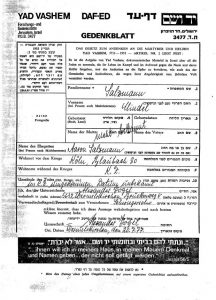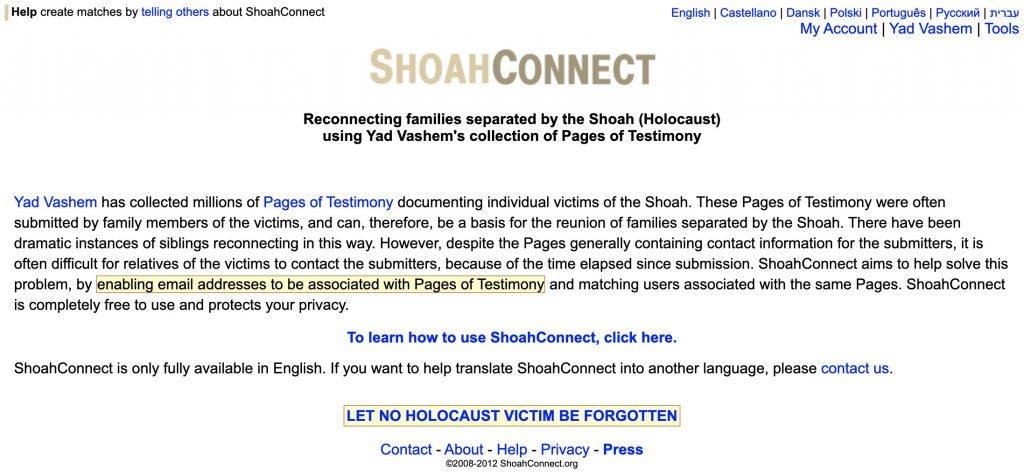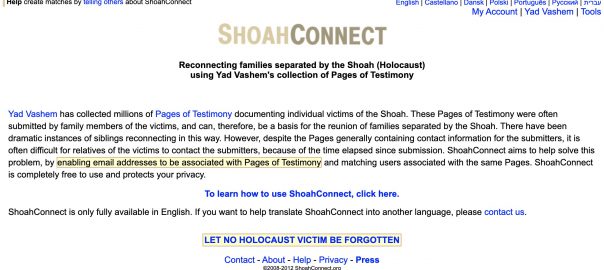
A major project of Yad Vashem, the Israel Holocaust museum, since its founding, has been to try to collect information on every victim of the Holocaust. This has taken a number of forms, but for many it is best represented by their Pages of Testimony project, which allows anyone to submit a page of information on someone they knew to have perished in the Holocaust. In many cases, these Pages of Testimony are the only record of existence of someone who died, as many primary records were destroyed in the war. Yad Vashem has made efforts over the years to collect these Pages from survivors and relatives of victims, including a big push in Israel in the 1950s to collect information. I remember over the years when visiting Yad Vashem, part of the visit would include searching their database for names of relatives, and being offered to submit names of people not in the database. In 2004 Yad Vashem finished digitizing all the Pages of Testimony and made the entire database available on the web (with some additional sources of information like transport lists – creating the Shoah Names Database), a major breakthrough for those researching their families, and also enabled a new push from Yad Vashem to gather information on victims not yet in the database. As the number of survivors dwindle, those with memories of relatives and friends who were murdered in the Holocaust, and if Pages of Testimony are not filled out soon, knowledge of some peoples very existence may be forgotten forever.
For the Jewish genealogist, searching the Pages of Testimony has long been a very powerful tool. While not every form was completely filled out, many forms include the name of the person, maiden name for women, the name of the person’s parents, where and when they were born, where they lived during the war, what their profession was, etc. All very important information for someone researching their family. To get the full impact of searching the database, it helps to learn how best to use the Advanced Search interface, which allows you to search by specific fields like town of birth, or maiden name. Searching by town alone is something I highly recommend if you know where someone was born, or where your family was primarily from in Europe, as it may show people that you either didn’t think of, or might show spellings that are different than you are used to seeing. The spelling issue is important since many of the forms were submitted in Hebrew, and had the English spellings transliterated automatically. Thus the spelling may be computer-generated, and not necessarily the same spelling you think it will be.
Another important technique for getting the most out of searching the Pages, is that once you find a Page about someone in your family, you should look to see who submitted the information. That person is likely related to you as well. Depending on when the Page was submitted, you may even be able to track down the person who submitted the Page and find out more, or in some cases track down their descendants. When you find a Page, note that there is a menu called Related Searches. The most important search is ‘Pages of Testimony by submitter(s) with the same name’. Most people who submitted Pages, submitted multiple Pages. By seeing which other Pages were submitted by the same person who submitted a Page on a family member of yours, you will likely find Pages of other family members (although some may be of friends or family members from the other side of their family). This search can also be replicated in the Advanced Search form by entering the name of the submitter, and then you can refine the search by adding other fields.
Some people who first find a record of a family member who died in the Holocaust by searching the Pages are frustrated when they realize that person who submitted the Page of Testimony is a relative that they were not aware of, yet the Page was submitted so long ago that they cannot track down the person (and many submitters are now deceased). In some cases, if the record was submitted by someone who lived in Israel, it is possible to track down the person or their descendant through a database kept by Magen David Adom (Israel’s Red Cross). There are individuals who have access to this same database and can probably search it quicker than going through the normal channels. Some of these people are professional genealogists who charge for this service, but I recommend joining the mailing list of the Israel Genealogical Society (which recently merged with the Jewish Family Research Association) and posting questions about people, as there are people on the list who can and probably will look up people for you for free.
There are other resources for tracking down survivors, or information on victims, such as the International Tracing Service, and connected services run through the American Red Cross and the USHMM. That is a whole different topic, however, perhaps for a later post.
So what happens if you find a Page of Testimony submitted by a relative you can’t track down, and may never be able to find, but through which you think you can reconnect to extended family? Here technology offers an interesting solution. Logan Kleinwaks, who also operates the genealogyindexer.org site, runs a site called ShoahConnect.org which is directly relevant. ShoahConnect does something very powerful – it allows anyone to connect themselves to a Page of Testimony, and if someone else uses the site to connect to the same Page, it will notify each person connected to the same Page that there are other people interested in the person on that Page of Testimony. This allows distant relatives to reconnect through their shared relation to a person recorded on a Page of Testimony on Yad Vashem’s site. As of this writing, there are 744 users of the site, with 10,978 connections. This uses a similar technique to the LostCousins.com web site which connects people through common relatives in census records in the US, Canada and the UK.

ShoahConnect utilizes the Google Toolbar to pull off it’s work, so it’s not quite a simple as selecting a name on a web site. However, once you have Google Toolbar installed (in Firefox for Mac and Windows, or Internet Explorer for Windows), clicking a link on the site adds a C-shaped button to the toolbar. The next time you are viewing a Page of Testimony you just click on the new button to link to that Page of Testimony. Follow the instructions on ShoahConnect to get everything set up, and then head over to Yad Vashem’s site and start adding connections.
One last point to make about Pages of Testimony and ShoahConnect – if you want to make connections to other relatives but can’t find relatives on Yad Vashem that you know perished in the Holocaust, you should submit Pages of Testimony for your relatives to the Yad Vashem site, and then link to the Pages you submitted using ShoahConnect. Another thing to remember is that you can provide your own contact information to the Page of Testimony so that if even if someone is not using ShoahConnect, but finds the Page of Testimony that you submitted, they will still be able to reach you based on the contact information you provided as the submitter of the Page of Testimony. If you have photos of the people you are submitting a Page of Testimony for, make sure to also submit the photos, as your branch of the family may be the only branch to have photos of that relative.
